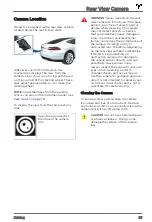
Braking Systems
WARNING:
Properly functioning
braking systems are critical to ensure
safety. If you experience a problem
with the brake pedal, brake caliper, or
any component of a Model S braking
system, contact Tesla immediately.
Model S has an anti-lock braking system
(ABS) that prevents the wheels from locking
when you apply maximum brake pressure.
This improves steering control during heavy
braking in most road conditions.
During emergency braking conditions, the
ABS constantly monitors the speed of each
wheel and varies the brake pressure
according to the grip available.
The alteration of brake pressure can be felt as
a pulsing sensation through the brake pedal.
This demonstrates that the ABS is operating
and is not a cause for concern. Keep firm and
steady pressure on the brake pedal while
experiencing the pulsing.
The ABS indicator briefly
flashes yellow on the
instrument panel when
you first start Model S. If
this indicator lights up at
any other time, an ABS
fault has occurred and the
ABS is not operating.
Contact Tesla. The braking
system remains fully
operational and is not
affected by an ABS failure.
However, braking
distances may increase.
Drive cautiously and avoid
heavy braking.
If the instrument panel
displays this red brake
indicator at any time other
than briefly when you first
start Model S, a brake
system fault is detected,
or the level of the brake
fluid is low. Contact Tesla
immediately. Apply steady
pressure and keep the
brakes firm to bring the
vehicle to a stop when
safe to do so.
Emergency Braking
In an emergency, fully press the brake pedal
and maintain firm pressure, even on low
traction surfaces. The ABS varies the braking
pressure to each wheel according to the
amount of traction available. This prevents
wheels from locking and ensures that you
stop as safely as possible.
WARNING:
Do not pump the brake
pedal. Doing so interrupts operation
of the ABS and can increase braking
distance.
WARNING:
Always maintain a safe
distance from the vehicle in front of
you and be aware of hazardous
driving conditions. While the ABS can
improve stopping distance, it cannot
overcome the laws of physics. It also
does not prevent the danger of
hydroplaning (where a layer of water
prevents direct contact between the
tires and the road).
Automatic Emergency Braking is designed to
automatically brake in situations where a
collision is considered imminent (see
Automatic Emergency Braking on page 121
WARNING:
Automatic Emergency
Braking is not designed to prevent a
collision. At best, it can minimize the
impact of a frontal collision by
attempting to reduce your driving
speed. Depending on Automatic
Emergency Braking to avoid a collision
can result in serious injury or death.
CAUTION:
In emergency situations, if
the brakes are not functioning
properly, press and hold the Park
button on the gear selector to bring
the vehicle to a stop. Do not use this
method to stop the vehicle unless
absolutely necessary.
Brake Disc Wiping
Model S is equipped with brake disc wiping,
which automatically assists in maintaining
brake responsiveness in cold and wet weather
conditions. When such conditions are
detected, brake disc wiping repeatedly
applies an imperceptible amount of brake
force to clear away water on the brake disc
surface. This ensures your brakes are
responsive even during poor weather
conditions.
Braking and Stopping
68
MODEL S OWNER'S MANUAL
















































